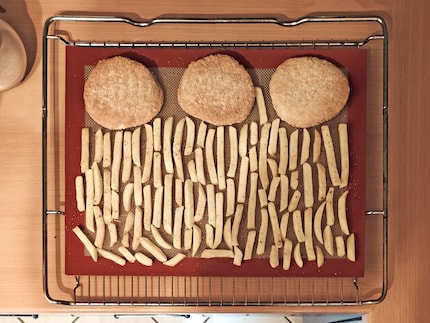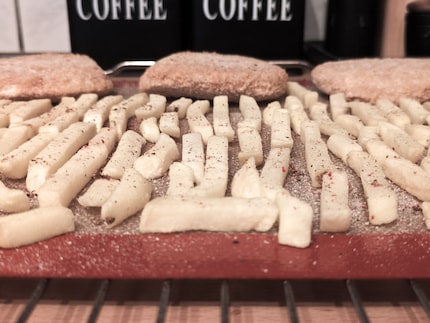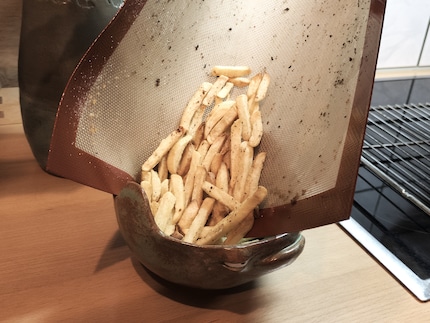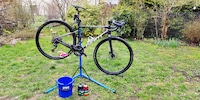

No more baking paper? Xavax silicone mat review
Can a silicone mat replace my baking paper? I was impressed on almost every level when I tested the silicone from Xavax.
Four months ago I switched to silicone because I was fed up of buying baking paper. And I have no regrets so far – the material’s never let me down in the 50 plus times I’ve used it. What I particularly like is the superb non-stick effect.
Despite many baking cycles, I haven’t even recouped half the price of my Xavax silicone baking mat yet. If I buy 30 sheets of Profissimo baking paper, one baking cycle costs me around 10 cents. Since the silicone baking mat cost me around 13 francs/euros, I have to bake with it at least 130 times before it pays off financially. I’m confident it’ll last far beyond that.
Why this particular mat?
When I place the red-brown Xavax silicone baking mat on the rack, it fits the width of my Siemens oven perfectly – it measures 40 × 30 centimetres. However, it could do with an extra 5 centimetres in length to completely cover the surface of the grate and the baking tray. I can get over a few centimetres, though.

I chose the Xavax model because of the many positive and only few negative comments. The mat is comparatively thick and of good quality for the price. It stops liquids and fat from finding their way onto the baking tray or grate – which is more than I can say for baking paper. I’m glad I don’t have to degrease the tray any more. Silicone is also easier and quicker to clean and, unlike the tray, fits in the sink.

This material allows you to clean the mat in the dishwasher and is more non-stick than paper. It’s even better than baking paper with a silicone coating – which almost all baking papers have. You can also pop them in the refrigerator or freezer. There’s just one occasion where you’ll still need to use a baking dish, and that’s when you’re cooking at very high temperatures because it can compromise the silicone.
Silicone and baking paper are completely safe to use up to 200 °C
According to the manufacturer, the product is heat-resistant up to 260 °C. However, in Switzerland, the Federal Food Safety and Veterinary Office (FSVO) has issued a precautionary recommendation for silicone kitchen utensils in that you shouldn’t heat above 200 °C, even if there’s a note saying you can use it in temperatures of - 60 °C to + 230 °C, or even + 280 °C (link in German).
This recommendation is based on the fact that traces of silicone components (polydimethylsiloxanes) can pass into the baked goods at higher temperatures. Although these shouldn’t pose a health risk as «polydimethylsiloxanes are not absorbed by the gastrointestinal tract», it’s still advised because the amount should be kept as low as possible. The Federal Office of Public Health made the following comparison in an SRF article: «When someone eats a sandwich, they don’t want to eat the packaging as well», (link in German).
Baking paper almost always has a silicone coating, but I can’t find a specific recommendation from the FSVO on this. Manufacturers usually specify a limit of 220 °C. However, Switzerland has adopted EU Regulation (EC) No. 1935/2004. This stipulates that materials mustn’t release any harmful substances into food. Yet the regulation doesn’t include concrete advise on the temperature limit for silicone.
How the silicone performs when baking
So what do you do when your chips need to be in the oven for 16 minutes at 220 °C?
Either you believe manufacturers who say their material can withstand high temperatures. Or you can follow the recommendation and simply bake the chips at 200 °C for 21 minutes. You have to experiment a bit – for the majority of baked goods, adjusted times and temperatures work quite well. Even with a longer, but less hot baking time, chips will turn out crispy on the outside and soft on the inside.

However, for grilled dishes or rustic bread with a thick crust, temperatures of 240 to 260 °C mean there’s no other option than to use a baking dish made of glass or metal. Unless you trust the manufacturer’s instructions for the silicone utensil.
What’s absolutely brilliant about the silicone mat is that if you spread honey-walnut cookies or a bread mix such as Wunderbrød on it and bake it, you can easily pull it off the silicone after baking. I’d always struggle with baking paper, despite the thin silicone coating.
Usage and cleaning tips
According to the Federal Office for Food Safety, silicone items intended for baking should be heated «for one hour at 200 °C» and then washed thoroughly before first use. So that’s what I did.
50 bakes later, my silicone mat still looks and feels like new. I always wash it by hand with mild washing-up liquid straight after each use, as it takes up too much space in the dishwasher. I never had the impression that cleaning would be difficult. However, I’ve never burnt anything on it. And I haven’t messed around with tomatoes or turmeric yet – these can cause discolouration.
If you’re prone to burning things, you can use a baking soda paste for cleaning. Simply mix a teaspoon of baking soda with a few drops of water. Alternatively you can dilute some lemon juice or vinegar and apply it selectively.

Under no circumstances should you use aggressive degreasers, as these contain strong alkalis or solvents. Agents containing chlorine or acid in high concentrations are also taboo. Not to mention, rough sponges and especially steel wool can also damage the material.
My final tip is that you shouldn’t pour oil directly onto the mat, as this can cause it to burn in more quickly. Do yourself a favour and clean it after each use. If the mat’s sticky and you’ve tried every cleaning method possible, throw it away. In addition to keeping clean, storing it on a flat surface away from UV light has a positive effect on the longevity of the product.
In a nutshell
No more baking paper
If you’re looking for an alternative to disposable baking paper, the Xavax silicone baking mat is the perfect choice. Just like baking paper coated in silicone, the disadvantage here is that it’s not suitable for high baking temperatures. At least, that’s what the Federal Food Safety and Veterinary Office recommends. The mat’s also slightly too small for my oven. There are five centimetres missing in length to fully fill the baking tray or grill grate.
Since my mat looks like new after more than 50 times in the oven, I assume I’ll have it for a very long time. A silicone mat can be used hundreds of times if the quality’s right and you maintain it well. So far, it’s played to its strengths and protects my favourite loaf of bread from sticking.
I’m very impressed by it and can recommend it as long as you’re aware that it needs to be cleaned after each use. The advantage is that you don’t have to clean the tray any more, since the mat’s impermeable whereas paper isn’t.
Pro
- Reusable
- Sticky baked goods come off better than with paper
- Impermeable (tray stays clean)
- Easy to clean
Contra
- Silicone (as well as baking paper) isn’t recommended at high temperatures
- Not quite as big as my tray at 40 × 30 cm

Xavax silicone baking mat, square, 40 x 30 cm, red-brown
40 x 30 cm
I find my muse in everything. When I don’t, I draw inspiration from daydreaming. After all, if you dream, you don’t sleep through life.


